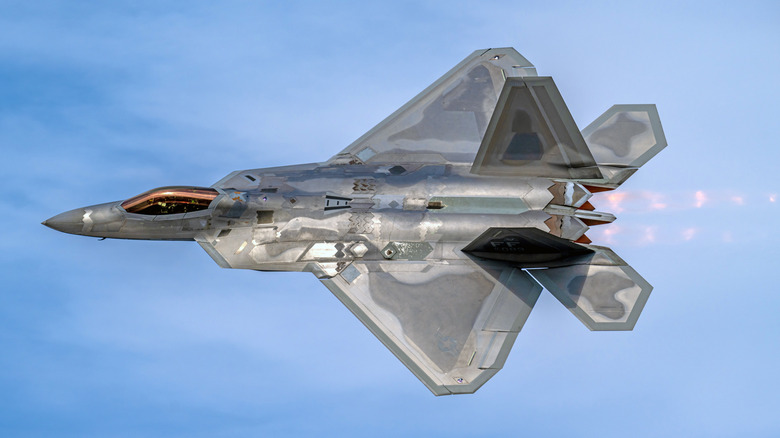Why The F-22 Raptor Has Never Had A Confirmed Kill In Active Combat
The F-22 Raptor was built to be the pinnacle of air combat dominance. The goal was to launch a next-generation replacement for its aging fleet of F-15 Eagles and F-16 Fighting Falcons, counter advanced Soviet threats, and secure American air superiority. Lockheed Martin's design won out. After its first flight in 1997, the Raptor entered service in December 2005.
With a wingspan of over 44 feet and two engines pushing 35,000 pounds of thrust each, it can reach speeds of 2,414 km/h while remaining extremely stealthy due to its low radar cross-section. It also carries a fearsome mix of air-to-air and air-to-ground weaponry and can hit moving targets from over 24 miles out. Still, despite all of this, the jet has never fired at another fighter in combat. That's a bit surprising considering its predecessor, the F-15, has racked up over 100 enemy aircraft kills. However, by the time the F-22 was ready for combat, the global battlefield had shifted.
During the 2000s, the US military was engaged in asymmetric warfare in the Middle East. Conflicts focused more on insurgency, with simply no hostile jets to fight. That's not to say that there was zero deployment, as F-22s still operated over Syria and Iraq. But their missions were largely ground-focused — specifically, striking ISIS positions and performing show-of-force flights. Add to that the jet's high operating costs and the emergence of the more versatile and cheaper F-35, and the F-22's window of relevance shrank even further. The Air Force originally wanted 750 of them, but ended up with just 187 operational aircraft.
A first 'kill' that wasn't the plan
The F-22 finally scored its first "kills" in early 2023, but not in a way anyone expected. The first target was a Chinese surveillance balloon drifting over the Atlantic near South Carolina. The jet used an AIM-9X Sidewinder missile to pop the 200-foot-tall high-altitude balloon that was reportedly carrying a payload the size of a jetliner. A few days later, another Raptor shot down an unidentified object over Alaskan airspace, this time cruising at 40,000 feet and described as about the size of a small car. While neither of these were hostile, they technically are confirmed air-to-air kills.
As for the future of the Raptor, production was already stopped in 2011, and the Air Force is gradually shifting focus toward sixth-generation fighters like the F-47 and drones. Still, there are planned upgrades like a new sensor package that could keep it in service through the 2040s. For now, the jet that was meant for air supremacy has settled into a quieter legacy — one of deterrence rather than full-blown battles.

